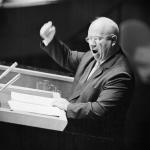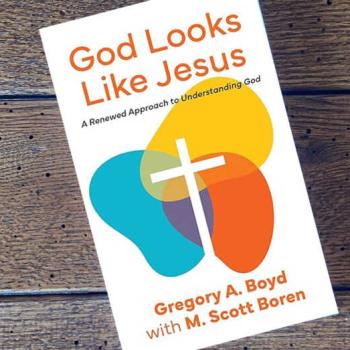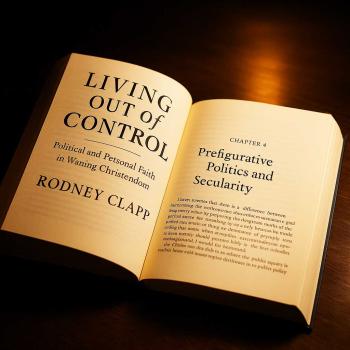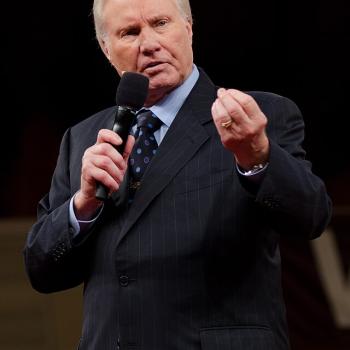A non-fundamentalist, evangelical narrative of the divide
Thanks to Don Johnson for his personal, fundamentalist account of the divide between fundamentalists and (neo)evangelicals. Here, below, is mine; it was taught to me in seminary (North American Baptist Seminary) and by people like George Marsden and Joel Carpenter, historians of modern evangelicalism. And, of course, I went on after seminary to become a leading historian and theologian of the American evangelical movement.
First, I insist on making a distinction between the evangelical “ethos” and the American evangelical movement. The movement, which was labeled “neo-evangelical by founding leader of the movement Harold John Ockenga, coalesced in the 1940s and 1950s with the formation of the National Association of Evangelicals, the founding of Fuller Seminary and Christianity Today, and the influence of Billy Graham (especially in the 1950s).
The evangelical ethos is shared by neo-evangelicals (now generally known simply as “evangelicals”) and fundamentalists, but with different “spins.” Or, to use another metaphor, it appears in different “flavors.” But the basic ethos goes back at least to the rise of Pietism and Revivalism in the 18th and 19th centuries. It existed before then, but those movements, sometimes called “the second reformation,” really gave it impetus.
Historians such as David Bebbington, Mark Noll, George Marsden and Joel Carpenter are widely considered the main scholars about both the evangelical ethos and the evangelical and fundamentalist movements and their division.
Here is the narrative they and others taught me and that is widely believed by non- or post-fundamentalist American evangelicals.
Beginning in the 1920s some evangelicals declared themselves militantly anti-liberal theologically and began a long process of separating from the liberal-leaning mainline denominations and institutions in America. By the early 1940s, however, many fundamentalists, some still functioning within mainline Protestant denominations, decided their fundamentalist friends had become too rigid, to exclusive, too anti-culture, too separatistic, etc. They also believed that many fundamentalist leaders, although evangelical “ethos-wise,” were losing influence in American social and cultural life. They believed they had gone too far “underground,” so to speak and were not interested in integrating Christian faith with new knowledge coming out of the sciences.
But, the founders of the NAE were most definitely not liberal theologically. They crafted a Statement of Faith that many denominations could sign onto while holding onto their own particularities.
The main reason for the founding of the NAE, however, was to counter the influence of the Federal Council of Churches over the government agencies that regulated the radio airwaves. Conservative Protestants felt they were being actively excluded by what is now called the Federal Communications Commission such that, for example, evangelical-fundamentalist radio preacher Carl McIntire was not able to get a license for his radio station so took it “off shore” on a ship, beaming his fiery preaching back to U.S. listeners. The founders of NAE wanted basically conservative, evangelical (ethos-wise) Protestants to band together to pressure the government to give their radio preachers equal time with more liberal preachers. However, the NAE moved on to other projects as well.
When the NAE was founded, in the early 1940s (in several stages) it invited both Pentecostal denominations AND fundamentalists such as Carl McIntire’s American Council of Christian Churches to join. The Pentecostals joined, but McIntire and the ACCC did not. One reason, I was always taught and read, was that McIntire would not join the NAE if Pentecostals were allowed to join.
Other evangelical-fundamentalist leaders such as John R. Rice and Bob Jones, William Bell Riley and J. Frank Norris also declined to join for whatever reasons. And, in spite of tremendous efforts of persuasion by the NAE founders, the Southern Baptist Convention declined to join. (Although it did sent “observers” to NAE board meetings.)
Some fundamentalists were favorable to Billy Graham and his ministry UNTIL he removed the race line in his crusade in Jackson, Mississippi in 1952. According to the narrative I was taught, that was a breaking point between many, perhaps most, fundamentalists and Billy Graham and by that time Graham was the figurehead of the post-fundamentalist, evangelical movement.
Now, of course, the fundamentalist narrative is different. It is that the divide happened when and because Billy Graham permitted members of the New York Council of Churches (affiliated with the Federal Council of Churches) to support and cooperate with his New York crusade in 1957. The post-fundamentalist evangelical narrative is that the break happened sooner than that and over race issues.
But the roots of the post-fundamentalist evangelical movement begun in the 1940s and the fundamentalist movement go back into the 1930s if not earlier. Many evangelicals were disenchanted with the militancy, separatism, divisiveness, especially among northern Baptists, throughout the 1920s and 1930s. And they were unhappy with the elevation of certain secondary doctrines to essentials of faithful Christianity to the status of litmus tests for fellowship and cooperation—especially dispensationalism, creationism (which later came to be called Young Earth Creationism), etc.
Now, I grew up in a small Pentecostal denomination that was a charter (founding) member of the NAE but included many “fundamentalish” people, including some leaders. While they and we admired Billy Graham and did not forbid inter-denominational cooperation and fellowship with fellow conservative Christians, including some who (God forbid!) baptized infants and used “modern Bible translations,” for the most part we accepted dispensationalism (the Scofield Reference Bible was pretty standard), pre-tribulation rapturism, premillennialism, and old-earth creationism without evolution as necessary within our own fellowship and we often looked down on even fellow evangelicals who did not agree. For example, we would not have invited someone who did not believe as we did to preach at our annual convention.
How do I know? Because my family and I were absolutely “plugged into” that small Pentecostal denomination, going right up into the HQ. My mother was the president’s secretary and my uncle became the president and served in that capacity for 25 years. He eschewed the label “fundamentalist,” but embraced “conservative evangelical” and was himself conservative to the point of being obscurantist about new developments in the sciences and culture generally.
A book that was published in the 1950s and then went through several editions was “The Christian View of Science and Scripture” by evangelical theologian Bernard Ramm who had a degree in science. It was an anti-fundamentalist polemic in which he pretty much said that fundamentalists are obscurantists because they refuse to learn about things like the age of the earth. The book served as a kind of manifesto of the new evangelical attitude toward the world outside the churches—cautious acceptance and willingness to learn from new facts and adjust our theology and interpretation of the Bible in light of them.
So that, in brief, is the narrative I learned really beginning in Bible college and from my uncle who served on the board of the NAE, and from reading numerous books about the history of the modern American evangelical movement.
During the 1960s and early 1970s “we” (post-fundamentalist evangelicals) considered Jerry Falwell a true-blue anti-evangelical fundamentalist, harshly critical of our new evangelicalism. Then, suddenly, in the late 1970s and early 1980s he was calling himself an evangelical and projecting an image of himself as a spokesperson for evangelicalism (on television shows like The Phil Donahue Show). At the same time, however, he was harshly critical of evangelicals like Jim Wallis who he considered a traitor to true evangelicalism. (I heard him say on radio that Jim Wallis and his Sojourners group was to evangelicalism what Hitler was to Catholicism.)
Gradually it became clear to many of us “new evangelicals” that the real difference between us and continuing fundamentalists, whatever they called themselves, was two fold: 1) a willingness or unwillingness to think new thoughts and hold somewhat lightly secondary doctrines such as “the rapture”, and 2) a “secondary separation” attitude and practice where true, blue fundamentalists would not cooperate with Billy Graham or NAE-inspired events and projects. Some readers may be old enough to remember “Key 73”—an evangelical evangelism project that was trans-denominational and led by evangelicals such as my uncle. As I recall, true blue fundamentalists would not join in with that or anything like that. They kept their distance from us even when warmly invited to come and participate.
*Note: If you choose to comment, make sure your comment is on topic, addressed to me, relatively brief (no more than 100 words), civil and respectful (not hostile or argumentative), and devoid of pictures or links.*














